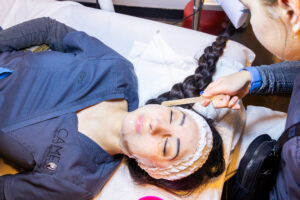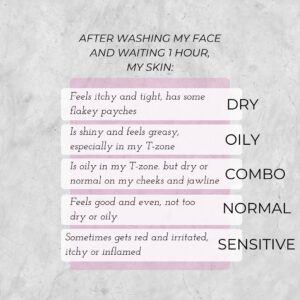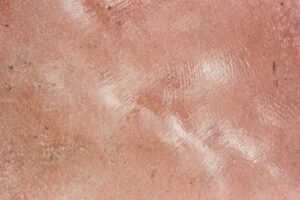7 Skincare Fundamentals Every Esthetician Student Should Master
Understanding skincare fundamentals is essential for every aspiring esthetician. These core principles form the foundation of professional skin care practice, guiding your treatment decisions and client consultations. Whether you’re starting beauty school or building your practice, mastering skincare fundamentals separates exceptional estheticians from average ones.

Acne Facial At Cameo College
Why Skincare Fundamentals Matter for Your Career
Before exploring advanced treatments, you need solid grounding in skincare fundamentals. These basics protect client skin health while establishing your professional credibility. When you understand skincare fundamentals deeply, you can customize treatments for each unique client need.
The beauty industry demands more than surface-level knowledge. Clients trust you with their skin health and appearance. That’s why skincare fundamentals include understanding skin anatomy, recognizing skin types, and selecting appropriate treatments. These skills directly impact client satisfaction and retention.
The Cost of Skipping Basic Training
Many new estheticians rush past skincare fundamentals to learn trending treatments. This shortcut causes problems quickly. Without solid skincare fundamentals, you risk irritating client skin, missing contraindications, and delivering poor results. Strong foundation in skincare fundamentals prevents these professional mistakes.
Understanding Skin Anatomy: Your First Skincare Fundamental
Your skin contains three primary layers working together. The epidermis forms the visible outer layer, protecting against environmental damage and moisture loss. This layer constantly renews itself, shedding dead cells while generating new ones beneath. Understanding this process represents crucial skincare fundamentals for treatment timing.
The dermis sits below the epidermis, containing collagen and elastin fibers that provide strength and elasticity. Blood vessels, nerve endings, hair follicles, and sebaceous glands reside here too. Damage to this layer causes wrinkles, sagging, and scarring. These skincare fundamentals explain why prevention matters more than correction.
The hypodermis (subcutaneous layer) consists mainly of fat cells providing insulation and cushioning. While estheticians rarely treat this deep layer directly, understanding its role forms part of complete skincare fundamentals knowledge.
Skin Cell Turnover and Renewal
Skin cell turnover takes approximately 28 days in young adults but slows with age. New cells form in the basal layer, gradually moving upward until they reach the surface and shed. These skincare fundamentals guide exfoliation recommendations and explain why results take time.
The 7 Essential Skincare Fundamentals
1. Accurate Skin Type Identification
Identifying skin type correctly ranks among the most critical skincare fundamentals. Five basic types exist: normal, oily, dry, combination, and sensitive. Each requires different products and treatment approaches. Misidentification leads to ineffective treatments or adverse reactions.
Normal skin shows balanced oil production with minimal imperfections. These clients need maintenance rather than correction. Oily skin produces excess sebum, causing shine and enlarged pores. This type benefits from oil-free, mattifying products. Dry skin lacks sufficient natural oils, feeling tight and showing flakiness. Rich, emollient products suit this type best.
Combination skin features both oily and dry areas, typically an oily T-zone with drier cheeks. This common type requires zone-specific treatment approaches. Sensitive skin reacts easily to products, stress, or environmental factors. Gentle, fragrance-free formulations work best here. Mastering these distinctions represents essential skincare fundamentals.

“Skin Type Chart” by rahallad is licensed under CC BY-NC-SA 2.0
2. Proper Cleansing Techniques
Cleansing forms the foundation of all skincare fundamentals. This step removes makeup, dirt, excess oil, and environmental pollutants. Inadequate cleansing prevents products from penetrating properly. Over-cleansing strips protective oils, causing irritation and increased oil production.
The double cleanse method represents advanced skincare fundamentals for makeup wearers. First, use an oil-based cleanser to dissolve makeup and sunscreen. Follow with a water-based cleanser to remove remaining impurities. This thorough approach ensures completely clean skin without harsh scrubbing.
Water temperature matters significantly. Hot water strips natural oils and dilates capillaries. These skincare fundamentals teach us that lukewarm water cleanses effectively while protecting the skin barrier. Pat skin dry gently rather than rubbing with a towel.
3. Strategic Exfoliation Methods
Exfoliation removes dead skin cells that dull complexion and clog pores. Two main types exist: mechanical and chemical. Both play important roles in skincare fundamentals, serving different purposes and skin types.
Mechanical exfoliation uses physical particles or tools to manually remove dead cells. Scrubs, brushes, and microdermabrasion fall into this category. Chemical exfoliation employs acids or enzymes to dissolve cellular bonds. AHAs, BHAs, and enzymes each offer unique benefits. Understanding when to use each method represents crucial skincare fundamentals.
Frequency depends on skin type and treatment intensity. Oily, resilient skin tolerates more frequent exfoliation. Sensitive or dry skin needs gentler, less frequent treatments. These skincare fundamentals prevent over-exfoliation, which damages the skin barrier and causes sensitivity.
4. Understanding pH Balance
Skin maintains a slightly acidic pH around 4.5-5.5, known as the acid mantle. This protective barrier defends against bacteria and maintains moisture. Products with inappropriate pH levels disrupt this balance. Understanding pH represents often-overlooked skincare fundamentals.
Alkaline cleansers strip the acid mantle, causing dryness and sensitivity. Toners with proper pH help restore balance after cleansing. These skincare fundamentals guide product selection for optimal skin health. Test product pH when possible, especially for clients with sensitive or compromised skin.
5. Moisturization Strategies
Every skin type needs moisture, though the type and amount vary. Moisturizers contain three main ingredient categories: humectants, emollients, and occlusives. Each serves different functions within skincare fundamentals.
Humectants like hyaluronic acid draw water into the skin. Emollients like plant oils soften and smooth the skin surface. Occlusives like petrolatum seal in moisture by preventing water loss. Effective moisturizers combine these elements in ratios suited to specific skin types. Understanding these distinctions represents advanced skincare fundamentals.
Layering products correctly maximizes results. Apply thinnest consistency first, building toward thicker products. These skincare fundamentals ensure each product penetrates properly. Morning routines prioritize protection, while evening routines focus on treatment and repair.
6. Sun Protection Principles
Daily sun protection ranks among the most critical skincare fundamentals. UV radiation causes premature aging, hyperpigmentation, and skin cancer. SPF 30 minimum provides adequate protection for daily wear. Higher SPF offers more protection during extended sun exposure.
Mineral sunscreens contain zinc oxide or titanium dioxide, sitting on skin’s surface to reflect UV rays. Chemical sunscreens absorb UV energy and convert it to heat. Both types work effectively when applied correctly. These skincare fundamentals teach proper application: one ounce for full body, reapplied every two hours during sun exposure.

Photo by Tara Winstead on Pexels
7. Ingredient Knowledge
Understanding active ingredients separates competent estheticians from exceptional ones. Vitamin C brightens and protects against free radicals. Retinol accelerates cell turnover and builds collagen. Niacinamide strengthens the skin barrier and reduces inflammation. Each ingredient requires specific application methods and contraindications.
These skincare fundamentals extend to recognizing potential irritants and allergens. Common culprits include fragrance, essential oils, and certain preservatives. Reading ingredient lists becomes second nature with practice. This knowledge protects clients and demonstrates professional expertise in skincare fundamentals.
Professional Facial Treatment Protocols
Professional facials apply skincare fundamentals in structured treatment sequences. Each step builds on the previous one, creating cumulative benefits. Standard facial protocols typically include consultation, cleansing, analysis, exfoliation, extractions (if needed), massage, mask, and final products.
The Consultation Process
Every facial begins with thorough consultation. Ask about current skincare routine, concerns, goals, lifestyle factors, and medical history. This information guides treatment customization. Strong consultation skills demonstrate your mastery of skincare fundamentals while building client trust.
Document findings carefully. Note skin type, conditions, contraindications, and treatment recommendations. This record helps track progress over multiple visits. These professional skincare fundamentals protect you legally while improving treatment outcomes.
Facial Massage Techniques
Facial massage improves circulation, promotes lymphatic drainage, and enhances relaxation. Various techniques suit different purposes. Effleurage (light stroking) soothes and distributes products. Petrissage (kneading) releases tension. Tapotement (tapping) stimulates and energizes.
These skincare fundamentals require practice to master. Proper pressure, rhythm, and movement patterns make the difference between amateur and professional service. Practice on mannequins first, then advance to live models under supervision.
Applying Skincare Fundamentals to Different Concerns
Acne-Prone Skin
Acne treatment requires specialized application of skincare fundamentals. Balance oil control with adequate hydration. Use non-comedogenic products exclusively. Incorporate chemical exfoliants like salicylic acid carefully. Educate clients about extraction limitations and realistic expectations.
Aging Skin
Anti-aging treatments combine multiple skincare fundamentals. Focus on collagen stimulation, antioxidant protection, and deep hydration. Incorporate peptides, retinol (when appropriate), and vitamin C. Address texture, tone, and elasticity comprehensively rather than targeting one concern alone.

Photo by rosario janza on Unsplash
Sensitive skin demands gentle application of skincare fundamentals. Avoid harsh actives, fragrance, and essential oils. Choose minimal ingredient products. Patch test everything before full facial application. These precautions protect clients while building your reputation for safe, effective care.
Hyperpigmentation
Treating uneven tone requires patient application of skincare fundamentals. Combine brightening ingredients like vitamin C, niacinamide, and kojic acid with diligent sun protection. Set realistic expectations about gradual improvement. Quick fixes don’t exist for pigmentation concerns.
Common Mistakes in Skincare Fundamentals
Even experienced estheticians sometimes violate basic skincare fundamentals. Over-treatment represents the most common error. More isn’t better with skincare. Excessive exfoliation damages the skin barrier. Too many active ingredients cause irritation and sensitivity.
Ignoring contraindications poses serious risks. Always check for medications, medical conditions, and allergies before treatment. These safety-focused skincare fundamentals protect both you and your clients legally and physically.
Skipping patch tests on sensitive clients creates unnecessary risk. This simple precaution prevents severe reactions. These protective skincare fundamentals should never be omitted, regardless of time pressure.
Building Your Professional Skincare Fundamentals Practice
Continuous education keeps your skincare fundamentals knowledge current. New ingredients, techniques, and research emerge constantly. Attend workshops, read industry publications, and pursue advanced certifications. This commitment to learning distinguishes exceptional professionals.
Practice makes perfect with skincare fundamentals. Work on classmates, friends, and family to refine techniques. Join practice groups with other students. This hands-on experience builds confidence and skill simultaneously.
Product Knowledge Development
Build comprehensive understanding of various product lines. Different brands formulate products differently, even when targeting the same concerns. These skincare fundamentals help you recommend products that match client budgets and preferences while achieving results.
Visit professional supply stores and beauty trade shows. Test products, attend demonstrations, and build relationships with brand representatives. This networking supports your skincare fundamentals knowledge while creating business opportunities.
The Business Side of Skincare Fundamentals
Understanding skincare fundamentals includes knowing how to communicate value to clients. Explain why certain products cost more or why specific treatments require multiple sessions. Educated clients appreciate quality and become loyal customers who refer friends.
Retail sales supplement your service income significantly. Recommend products based on genuine need, applying your skincare fundamentals knowledge. Clients trust estheticians who prioritize skin health over sales commissions. This integrity builds long-term relationships and repeat business.
Track your treatment outcomes carefully. Document which product combinations work best for different skin types and concerns. This data-driven approach to skincare fundamentals creates consistency and improves results over time.
Your Path Forward with Skincare Fundamentals
Mastering these skincare fundamentals takes dedication and practice. Start with one concept, practice until it becomes instinctive, then add another. This systematic approach builds solid skills without overwhelming you.
Find a mentor who excels at skincare fundamentals. Watch how they assess skin, select products, and execute treatments. Ask questions and request feedback on your work. This guidance accelerates your learning significantly.
Stay curious about skincare fundamentals throughout your career. Each client teaches something new. Each challenge helps refine your approach. The best estheticians never stop learning and growing professionally.

Cameo College Success Stories | Estefania
Conclusion
These seven skincare fundamentals form the foundation of every successful esthetics career. From understanding skin anatomy to mastering professional facial protocols, these principles guide your professional development. Master these basics thoroughly before pursuing advanced specializations.
Your commitment to excellence in skincare fundamentals shows in every client interaction. Clients recognize when their esthetician truly understands skin health and protection. This expertise builds trust, generates referrals, and creates career longevity.
Remember that learning skincare fundamentals is an ongoing journey, not a destination. Stay committed to education, practice consistently, and always prioritize skin health over trends. These principles will serve you well throughout your entire esthetics career.

